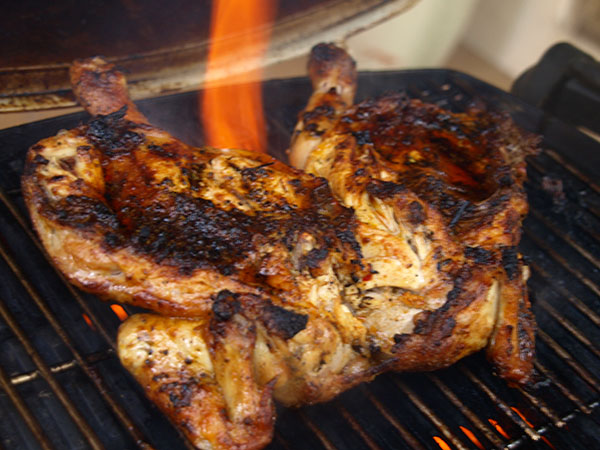The summer rolls on. The house tank is now under a third full, we haven’t had any rain in Jamieson since before Christmas. The sun has burned the grass to a straw colour. The temperature has been sitting in the thirties for weeks. In the afternoon the birds seem dazed, wandering around with their beaks open as if they were panting like my dog, who spends the days lying in the courtyard, prostrate on the cool terra-cotta tiles beneath the grape vines.
For some reason last night I came down with an insatiable craving for Umami, the so called fifth flavour (after sweet, sour, bitter and salty). Umami was enjoyed by the Romans, who used their Garum (fermented fish sauce) to add Umami and salt to thier dishes, and given its pungent odour, imposed strict sanctions under law against the indiscriminate placement of Gurum factories. Escoffier was famous for his use of Umami, although he was conscious of the flavour, but not the science. Kaiser Wilhelm was reputed to have once said to Escoffier, “I am the Emperor of Germany, but you are the Emperor of Chefs.” But I digress gentle reader.
In 1866, a German chemist named Karl Heinrich Leopold Ritthausen uncovered Glutamic acid. In 1908 Kikunae Ikeda, a Japanese chemist discovered the component that produces the flavour of seaweed, tomatoes and meat, which was glutamate. He detected the chemical root, named the taste sensation Umami and patented Monosodium Glutamate. Yes, good old magic powder, MSG. Business boomed, and the resulting commercial empire, the Ajinomoto Co. today produces 33% of the worlds MSG. As a sideline they acquired the rights to Aspartame from Monsanto in 2000 for $67,000,000. The company is active in 100 countries, employs nearly 25,000 people and earns around $9 Billion per anum.
Soon after Ikeda uncovered glutamate, a student of his, Professor Shintaro Kidama was fiddling around with dried bonito and uncovered another umami chemical, the ribonucleotide IMP. The great leap forward came in 1957, when Akira Kuninaka discovered another ribonucleotide, GMP in shitake mushrooms. He studied the synergy between IMP, GMP and MSG and came up with TASTY. It was basically a scientific explanation as to why some things taste so good when combined. For example Parmesan with Tomato, tomato sauce with beef, the classic mirepoix with beef stock, dashi, swiss gruyere with beef stock in french onion soup, anchovies with parmesan in Caesar salad. The list goes on and on.
Why I had such a craving for umami is more complex. Other cravings are easier to explain. For example, humans are hardwired to crave sugar, which along with other carbs stimulates the release of the feel good brain chemical seratonin. Salt carvings are curiously often caused by dehydration, not drinking enough, or perhaps too much…Sodium aids the body in fluid retention. Psychologist and author of “The Shangri La Diet” Seth Roberts, who is also an obsessive blogger http://blog.sethroberts.net , reckons that Umami is the minds way of healing the body. He hypothesises that our bodies naturally crave umami in order to tricking us into eating bacteria -that we need regular immune stimulation to be in optimal health and long ago, when we evolved, we got that stimulation from bacteria in our food.
Whatever it was I went into overdrive in the kitchen, and last night as the cool air flowed down the valley extinguishing the heat of the day we dined on Portugese Grilled Chicken, a chili tomato and roast capsicum salad and a white anchovy and white bean salad.

Quick Grilled Portugese Chicken Recipe
Recipe: Portugese Grilled Chicken
Summary: Delicious simple chicken on the weber
Ingredients
-
- 1 whole quality chicken
-
- 2 tablespoons butter
-
- 2 tablespoons olive oil
-
- 1 red chilli
-
- half cup lemon juice
-
- 1 teaspoon lemon zest
-
- 1 teaspoon bay leaf powder
-
- 2 tsp dolce sweet paprika
-
- slosh of whisky
- flaky salt and pepper
Instructions
- Spatchcock chicken by running knife or shears along each side of the backbone, remove backbone and flatten chicken
- Make a marinade by whisking all other ingredients in a food processor until smooth
- Roast chicken in pan on trivet over grill with lid closed at around 180 for 40 minutes
- Remove pan and trivet and place chicken on grill directly, pour over juices and grill for ten minutes each side, basting with marinade.
- Remove from grill, carve and serve with piri piri sauce.
Quick notes
If you don’t have bay leaf powder just pound dried bay leaf in a mortar and pestle Be careful when basting as the whisky tends to flame, which is great for the grill but not good if you burn yourself with too much of a flare up
Preparation time: 10 minute(s)
Cooking time: 1 hour(s)
Number of servings (yield): 6
Culinary tradition: Spanish

Sounds fantastic! Could the chicken be butterflied (squashed)?
Absolutely Sal, you can butterfly the chook, you can even do it with a Maryland a drumstick, or wings. Any part of the bird, so long as it has skin. Thank you for reading my blog and posting!